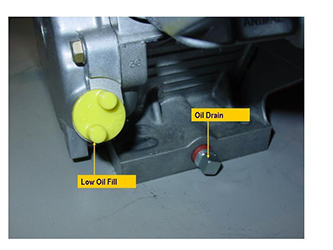How do I check and change lawn mower oil?
Since there are many components to checking and changing lawn mower oil, we break down:
How to Check the Oil Level
How to Change the Oil
How to Locate the Oil Drain
WARNING: Always read the engine and equipment manual(s) before starting, operating, or servicing your engine or equipment to avoid personal injury or property damage. See an authorized dealer or contact Briggs & Stratton if you are unsure of any procedure or have additional questions. Find all Engine Safety Warnings
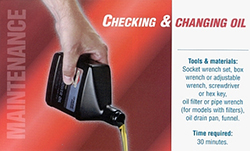
When you pour fresh oil into the crankcase, it's a golden or amber color. Gradually, the heat, dirt particles and agitated air in the crankcase cause the oil to darken. Dark oil is not only dirty; it has also lost much of its ability to coat and protect engine components.
When to Change the Oil in Your Small Engine
- Every 50 hours of operation or season.
- For a new snow blower or lawn mower engine, you'll also need to change the oil after the first five hours of operation.
- Beyond hours, also check the oil every time you use it. Dusty/dirty conditions and tough conditions, such as wet grass, heavy dust, high temperatures and rough or hilly terrain, may increase the frequency of required oil changes.
The new EXi mower engine doesn’t require oil changes, so you only need to check and add oil.
Make it a habit to check the oil level and appearance each time you're about to start a small engine. Checking the oil while the engine is cold and most of the oil is in the crankcase yields the most accurate reading.
For oil checking procedures on lawnmower applications, please watch our "Checking Engine Oil - Lawnmower Engine" video:
- Step 1: Locate the oil fill cap on the crankcase to start. Fill cap locations vary, depending on the make and model of your engine.
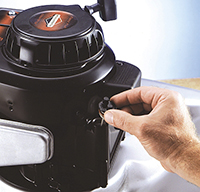
- On newer models, look for an oil can symbol or the word "oil" or "fill" stamped on the plug.
- On small tractors, you may have to lift the hood to locate this cap.
- Some engines contain either an extended oil fill tube or a standard fill hole with a dipstick for inspection.
- Others require you to remove the fill cap to check that the oil is at the fill line or the top of the fill hole.
- Step 2: Clean the Crankcase: To prevent dirt and debris from falling into the crankcase, use a clean cloth to wipe the area clean before removing the cap.
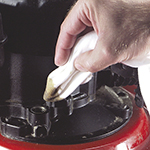
- Step 3: Inspect the Oil. If there is no dipstick, dab the oil with a clean tip of the cloth to inspect the oil. If the engine includes a dipstick cap, remove the dipstick and wipe it with a clean cloth.
- To ensure an accurate reading, reinsert the dipstick completely. If the dipstick cap is a screw-in type, ensure an accurate reading by screwing in all the way before removing it to check the level.
- Then, remove it again and check the oil level.
The oil mark on the dipstick should be between the lines shown on the dipstick. It should never be above the FULL line or below the ADD line.
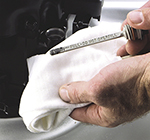
After checking the oil level and reading through the Oil Type & Capacity FAQ it’s time to run the engine for several minutes. Draining the oil while it's warm will carry off many floating particles that would otherwise settle in the engine.
For oil changing procedures on lawnmower applications, please watch our "Changing the Engine Oil - Lawnmower Engine" video:
- Step 1: Stop the engine then disconnect the spark plug lead and secure it away from the spark plug. Then, locate the oil drain plug. On mowers, the plug is typically below the deck and may be obscured by a layer of grass and debris.
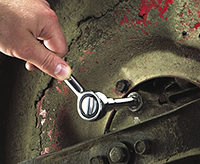
- Step 2: Drain the Oil. Wipe the area with a rag to prevent debris from falling into the crankcase when you open the drain plug. Either use a Briggs & Stratton oil removal kit to remove the oil or do it manually. Tilt the mower deck and position some newspaper and an oil pan or jug beneath the mower. Use a socket wrench to run the plug counterclockwise, allowing the old oil to drain. If the plug also serves as a fill cap, it may have two prongs so you can loosen it by hand or use a screwdriver or hex key for additional torque. Replace the drain plug by twisting clockwise and tightening with a box wrench or adjustable wrench.
- Step 3: Change the Filter. If your engine has a filter, replace it at least once a season, more often under heavy use (see Small Engine Maintenance FAQ). Replace the oil filter by twisting counter-clockwise on the body, using a filter wrench or pipe wrench. Lightly oil the filter gasketwith clean engine oil. Install new filter rated for your engine. Screw in the filter by hand until the gasket contact the filter adapter and tighten the filter an additional 1/2 to 3/4 turn.
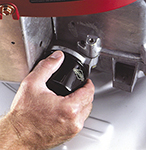
- Step 4: Add lawn mower oil to capacity (see your Operator's Manual). Then, run the engine at idle and check for leaks. Avoid overfilling the crankcase. Too much oil can cause the same type of engine damage as not having enough.
- Step 5: Dispose of oil and soiled ragsin accordance with local environmental statutes. In many areas, oil can be left at curbside with other recyclables, provided it is sealed in a recyclable container. Also, you can drop it off with a participating Briggs & Stratton service dealer.
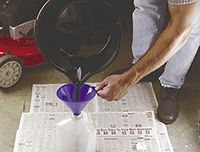
Rather than tipping your mower to change the oil, you may utilize the Oil Drain which is very effective, but can be difficult to locate on the underside of your mower. Typically, however, on vertical shaft engines, the oil drain plug is located beneath the engine block near the crankshaft.
To remove the square plug, all that is required is a standard size 3/8" ratchet and extension (no socket).
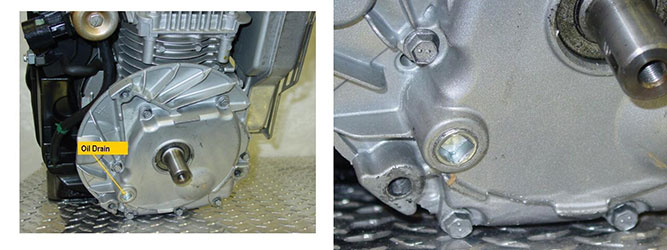
On horizontal shaft engines it would be located below the centerline of the crankshaft, on the base of the engine block. Typically an adjustable wrench would remove the square plug.
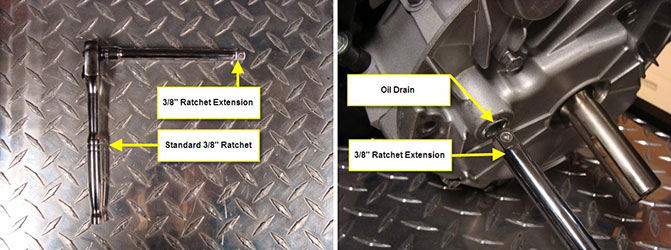
PLEASE NOTE: Vertical shaft engines, Series 300 to 550, may not feature a bottom oil drain as shown above. If this is the case, oil must be poured out of the oil fill tube as outlined in your engine Operator's Manual.
